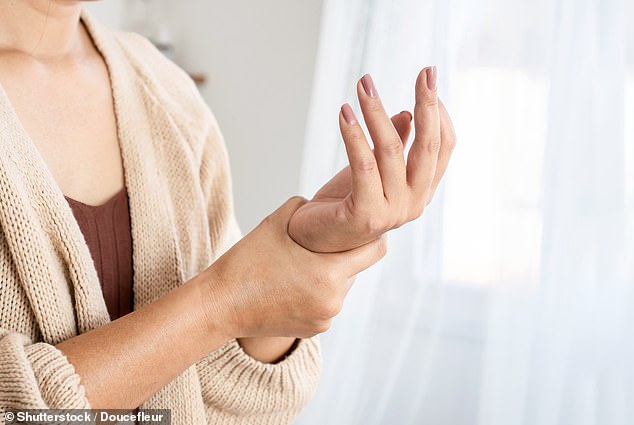Researchers have developed an exercise routine which can reduce agonising arthritis pain in less than two months.
The innovative workout is designed specifically for patients with rheumatoid arthritis, when the immune system mistakenly attacks healthy joint tissue, leading to painful swelling.
It involves patients carrying out a series of resistance training exercises while wearing a cuff – a tight strap that restricts blood flow to the limb.
A study, published this month, found that arthritis patients who did two hour-long sessions of this exercise routine every week saw significant improvements to their pain levels and muscle strength in less than eight weeks.
Experts are now calling for the programme to be tested on NHS patients – in combination with medicines – in order to tackle the debilitating condition.
‘This is a brand new approach to helping arthritis patients exercise,’ says Dr Mark Russell, a lecturer in rheumatology at King’s College London. ‘Along with medication, we know that exercise is really important to improving the pain patients experience.
‘This approach definitely deserves further investigation.’
More than 1.3 million people in the UK have rheumatoid arthritis. The most common symptoms are joint pain, swelling and stiffness. Typically these occur in the hands and feet but are also known to affect other joints.

A study, published this month, found that arthritis patients who did two hour-long sessions of this exercise routine every week saw significant improvements to their pain levels and muscle strength in less than eight weeks
Many patients also experience fatigue, sweating, poor appetite and weight loss.
It is not known what triggers rheumatoid arthritis but women are three times more likely to develop it than men. It is also thought to run in families.
The disease cannot be cured but there are a number of drugs which can control the symptoms.
The most common are a form of medicines called biologics which limit the immune system’s attacks on joint tissue. The most common of these regular injections is a drug called adalimumab.
However, along with medicine, experts say patients are advised to regularly exercise. This is because research shows that physical activity reduces the painful symptoms and also improves mobility in stiff joints.
But experts say many rheumatoid arthritis patients struggle to exercise due to their pain.
As a result, patients are also more likely to have lower muscle strength than healthy people.
This is because, due to their symptoms, they are generally less likely to exercise.

More than 1.3 million people in the UK have rheumatoid arthritis. The most common symptoms are joint pain, swelling and stiffness. Typically these occur in the hands and feet but are also known to affect other joints.
Studies show that a lack of muscle strength in old age raises the risk of life-threatening falls.
‘We know that the best way to prevent muscle loss is resistance training – using weights,’ says Dr Russell. ‘And there’s very good research that shows that regular exercise lowers pain levels.
‘But I often hear from patients who say that they worry that exercising will make their symptoms worse, so they end up avoiding it.’
In the new study, carried out by researchers at the University of South Australia, rheumatoid arthritis patients were asked to carry out a series of weight-based exercises, focusing on the leg and arm muscles.
However, these exercises were done while wearing a tight blood flow-restricting cuff around whichever limb they were using at the time.
The aim of this approach is to make the muscles work harder, as they require oxygen for energy which is transported by the blood. Without this oxygen, the researchers argue, the muscle tissue is put under more strain, which ultimately increases strength.
The experts involved in the research say this approach allows patients to lift relatively light weights – thereby avoiding the risk of injury or flare-ups – while also building muscle strength.
Around 100 patients took part in the trial. After two months – during which time the size of the weights was gradually increased – the researchers found that participants showed significant improvements in strength, movement and pain levels.
‘Rheumatoid arthritis can cause a loss of muscle mass and strength, which affects day-to-day activities, independence, and increases the risk of falls and fractures,’ says Dr Hunter Bennett, a lecturer in exercise and sports science at the University of South Australia and lead researcher of the study. ‘Resistance training is one of the best ways to rebuild that strength. This kind of training could be a game-changer for people with rheumatoid arthritis.
‘It offers a way to build strength without pushing through discomfort. That’s incredibly empowering for people who’ve often been limited by their condition.’











